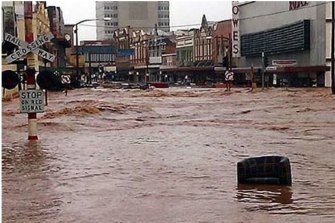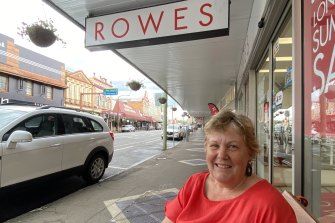Every year for the past decade, one of Toowoomba’s oldest stores, Rowes, has posted the same photograph on its website on January 10.
In it, a sodden lounge chair is wedged upside down on a Russell Street parking meter – an oddity only revealed once the torrent subsided, exposing the damage caused by an “inland tsunami” in 2011.
An armchair sits impaled on a parking meter opposite Rowes in Russell Street the day after the January 10 floodwaters rushed through the regional city in 2011.Credit:Michelle Szepanowski
The city of Toowoomba sits 691 metres above sea level on a strip of the Great Dividing Range about 119 kilometres inland from Brisbane.
Ten years ago,turbulent floodwaters swirled angrily into the CBD after 160 millimetres of rain fell in 36 hours on top of a month’s record rainfall, turning the normally calm West and East creeks into a frothing, angry river.
That river, at the top of the Great Dividing Range, tragically led to the deaths of two people – mother and son Donna and Jordan Rice – after their car stalled in the rising water.
Across the state, 33 people died and three remain missing from the January 2011 floods, which affected 78 per cent of Queensland and caused $2.38 billion in damages.
Toowoomba’s original main road, Russell Street, arose in the 1850s, and by the 1860s was home to the town’s first post office, police station, pub and public toilet.

Floodwaters roar through Toowoomba’s Russell Street on January 10, 2011.Credit:Claytonnnn on Twitter 2011
The railway line that crosses it runs parallel to Victoria Street and beneath a small bridge where West Creek dips to meet East Creek.
In the middle of Russell Street is Rowes Furniture Store, where it has been for 129 years, since 1892.

January 2021: Little has changed at the Russell Street and Victoria Street intersection in Toowoomba since the floods of January 2011.Credit:Tony Moore Brisbane Times
Rowes administrative assistant Michelle Szepanowski was working on January 10, 2011, when the dirty brown water flowed through the shop like a river.
“It scares me when there are floodwaters around,” she said.
“I was driving home to Kingsthorpe about 9pm that night [about 30 minutes towards Dalby] and I honestly don’t know how I got home because all of the creeks I’ve always crossed were washed out and flooded.
“When I came back the next day, there was no road there. Ruthven Street, Bridge Street, it just looked like a bomb had hit the place. It was just devastation. Cars were turned over. It was horrible.
“We started off trying to sandbag the front doors because there was a bit of water coming up the street over the footpaths.

Rowe’s Furniture employee Michelle Szepanowski. “Furniture was being washed out the front door into Russell Street.”Credit:Tony Moore
“It was about two o’clock in the afternoon. It started to come in through the front doors off Russell Street and then suddenly, it was just a huge flood coming in from the back and through the back doors and through the office.”
Eventually the water in the store’s lower display room was almost two metres high and washing heavy furniture out the front door and against the hotel walls across the road.
“All the windows and front doors were smashed, and the furniture was all out in the street,” Ms Szepanowski said.
“I remember calling [owner] Mr Rowe at the time and telling him that all the furniture was washing down Russell Street and going down West Creek and out into the country. He was just flabbergasted.”

Rowes warehouse manager Wayne Miller stands waist deep in floodwater as furniture floats out to Russell Street.Credit:Michelle Szepanowski
A decade on, most of Russell Street’s shops have remained. The saddlery stayed. The National Hotel stayed. Mike Williams Country Clothing stayed.
Rowes has begun a major $11 million redevelopment, which should be finished by mid-year.
Significant flood recovery work has been completed, however Russell Street itself is now in line for a facelift.

Business retailer Rob Mercer says little has changed in Toowoomba’s Russell Street.Credit:Tony Moore
Straight across the road from Rowes, fourth-generation business operator Rob Mercer is waiting for Toowoomba Regional Council to also rejuvenate Russell Street, which was the city’s original “high street”. Today it is Margaret Street.
“At the moment, not a lot has changed. It’s still a situation normal,” Mr Mercer said.
“We haven’t had a lot of [improvement] works done. We have all got back on our feet to continue doing business in Russell Street, but we are waiting for the changes, which begin next month.
“Council comes along next month and begins doing a revitalisation of the street, which is very exciting.
“We will end up getting new footpaths, new underground services, a green treed area, and a softening of the area, which hopefully will bring people back down here again.”
Queensland’s 2010-2011 floods
- Lives lost: 33
- Insured cost: $2.38 billion
- Buildings damaged: 29,000
- Homes damaged: 3600
- Evacuated: 5900
- “When Tropical Cyclone Tasha met an extreme La Niña weather pattern, enough water to fill three million Olympic swimming pools rained down on Queensland. Dams and rivers broke their banks and swamped an area the size of France and Germany combined.”
Source: Australian Institute of Disaster Resilience
Tony Moore is a senior reporter at the Brisbane Times
Most Viewed in National
Loading







